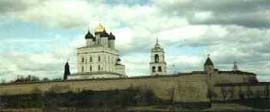| English | Русский |
 |
The Pskovian Land
Here is some interesting info about Pskov, that I scanned from "The Pskovian Land" book (C) Lenizdat, 1982. All thumbnails are clickable.









The Pskov Region
 The Pskov Region is a land with a rich
historical past, modern industry and developed agriculture. It is a relatively new
administrative division. Before the Great Patriotic War of 1941-45, Pskov war the
center of a military district, then part of the Leningrad Region. On august 23, 1944, immediately
after the expulsion of the Nazis, the Presidium of the Supreme Soviet of the USSR issued a
decree giving these lands the status of a region. Today the area is 55,000 sq km with a
population of over 800,000. These parts are justly called the oldest in Russia. They began
to be settled as early as the Neolithic, or even before that. Towards the onset of the
eight century the Slavic tribes Krivichi came from the upper reaches of the Dnieper to the
eastern shores of Lakes Pskov and Peipus (Chud), and the basin of the Velikaya River and
its tributaries. In order to defend themselves against their hostile neighbors, the Slavs
put up fortified settlements many of which later became impregnable citadels. The oldest
of these, Pskov and lzborsk, are first mentioned in the Tale of Bygone Years i for the
years 903 and 862. 'o The geographic position of Pskovian lands in the northwest of Russia
had long been such that for many centuries they served both as a gate wide-open for a good
friend and as a reliable barrier against a possible invader. Towards the fifteenth century
a powerful network of fortifications was built there, with the Pskov Fortress comprising
several defense lines standing at its center. The old lzborsk Fortress was reconstructed
in stone, and new fortifications were raised in Gdov, Ostrov, Porkhov, Vrev and Voronich,
The last to be built was the Pechory Fortress, erected at the beginning of the Livonian
War (1558-83). The Pskovian lands witnessed many events that had vital importance for the
destiny of this country. In April 1242, Russian troops led by Alexander Nevsky dealt a
crushing blow at the German knights-crusaders on the ice of Lake Peipus. From the early
fourteenth to the early sixteenth century the lzborsk Fortress had withstood eight enemy
sieges. In 1581, the army of Stephen Bathory, King of Poland, failed to capture Pskov and
Pechory. The same fate was in store for Gustav Adolf, King of Sweden, who besieged Pskov
in 1615.
The Pskov Region is a land with a rich
historical past, modern industry and developed agriculture. It is a relatively new
administrative division. Before the Great Patriotic War of 1941-45, Pskov war the
center of a military district, then part of the Leningrad Region. On august 23, 1944, immediately
after the expulsion of the Nazis, the Presidium of the Supreme Soviet of the USSR issued a
decree giving these lands the status of a region. Today the area is 55,000 sq km with a
population of over 800,000. These parts are justly called the oldest in Russia. They began
to be settled as early as the Neolithic, or even before that. Towards the onset of the
eight century the Slavic tribes Krivichi came from the upper reaches of the Dnieper to the
eastern shores of Lakes Pskov and Peipus (Chud), and the basin of the Velikaya River and
its tributaries. In order to defend themselves against their hostile neighbors, the Slavs
put up fortified settlements many of which later became impregnable citadels. The oldest
of these, Pskov and lzborsk, are first mentioned in the Tale of Bygone Years i for the
years 903 and 862. 'o The geographic position of Pskovian lands in the northwest of Russia
had long been such that for many centuries they served both as a gate wide-open for a good
friend and as a reliable barrier against a possible invader. Towards the fifteenth century
a powerful network of fortifications was built there, with the Pskov Fortress comprising
several defense lines standing at its center. The old lzborsk Fortress was reconstructed
in stone, and new fortifications were raised in Gdov, Ostrov, Porkhov, Vrev and Voronich,
The last to be built was the Pechory Fortress, erected at the beginning of the Livonian
War (1558-83). The Pskovian lands witnessed many events that had vital importance for the
destiny of this country. In April 1242, Russian troops led by Alexander Nevsky dealt a
crushing blow at the German knights-crusaders on the ice of Lake Peipus. From the early
fourteenth to the early sixteenth century the lzborsk Fortress had withstood eight enemy
sieges. In 1581, the army of Stephen Bathory, King of Poland, failed to capture Pskov and
Pechory. The same fate was in store for Gustav Adolf, King of Sweden, who besieged Pskov
in 1615.All these fortresses retained their strategic importance up to the end of the Great Northern War (1700-21), when Pskov and Pechory served as Russia's strongholds. By order of Peter I they were reconstructed and the tsar himself supervised the work when he visited these frontier towns. Today the remains of the once formidable walls and towers bring to mind those glorious historic battles that were fought on Pskovian soil. But the greatness of this ancient Russian land is not limited to war exploits alone. Numerous works created there by gifted architects, artists and craftsmen have come down to our time. The architectural heritage is especially noteworthy. By the early fourteenth century, a school of architecture with a distinctive idiom all its own was formed there. Its salient features were an amazing plasticity of form and the picturesque silhouette of a structure which was well integrated into the surrounding environment. The superb workmanship of Pskovian builders was known far and wide in Russia; they were invited to fulfill commissions in Moscow, Kazan and Sviyazhsk, Wonderful relics of the spiritual and material culture of the region, such as historic records, manu-scripts, archeological finds, easel paintings and objects d'art are housed in major Soviet museums.
Many great sons and daughters of Russia lived and worked in this part of the country. "Two fleeting years" were spent by Alexander Pushkin in the village of Mikhailovskoye. The masterpieces of poetry and prose he created there have enriched the treasure-chest of world literature. The village of Karevo, Kunyino District, is the birthplace of the composer Modest Mussorgsky. Another Russian composer, Nikolai Rimsky-Korsakov, lived in a picturesque place called Vechasha, Pliusk District; he wrote eight of his operas there, including Sadko, The Tsar's Bride and The Tale of Tsar Sultan. Born in the village of Polibino, Velikiye Luki District, were the sisters Anna and Sophia Korvin-Krukovsky. Sophia (married name Kovalevskaya), an outstanding mathematician, was the first Russian woman to become an academician. Her elder sister, Anna, fought on the barricades of the Paris Commune.
A memorable chapter in the history of the region is connected with Lenin's sojourn in Pskov in the spring of 1900. It was there that the great proletarian leader laid the foundations for the clandestine national Marxist newspaper lskra (The Spark). Its Pskov group, organized on Lenin's initiative and headed by P. Lepeshinsky, played a prominent part in preparing for the Second Congress of the Russian Social-Democratic Labour Party (RSDLP). The program adopted by the congress, laid the beginnings of a Bolshevik party.
Thousands of Pskovians were actively involved in the events of the October Revolution, in the struggle for the victory and consolidation of Soviet Power. In February 1918, when the slogan "Socialist Homeland in Danger" sounded through-out the country, the first Red Army regiments and workers' armed detachments fought a decisive battle near Pskov against the hordes of Kaiser Germany that were advancing on Red Petrograd. An extraordinary courage and fortitude in the battles against the invaders and counter-revolutionaries was displayed by Jan Fabritius, a Latvian commissar who subsequently became a prominent military figure; Leon Pozemsky and Paulina Yudeiko, leaders of the Pskov Komsomol organization; and M. Usharnov, K. Gei and B. Pozern - all Bolsheviks and members of the Military and Revolu-tionary Staff for Pskov's Defense.
During the rehabilitation of the national economy and socialist construction large-scale changes were being effected in the Pskovian lands: industrial enterprises were put into operation, new educational and cultural institutions were opened, collective farms organized and new blocks of flats built in large numbers.
The Great Patriotic War against Nazi Germany was for the Pskovians, as for the entire Soviet people, a severe trial which called for the extreme intensification of all spiritual and physical powers. The location of Pskov on the route to Leningrad determined its place in the Wehrmacht's plans of a Blitzkrieg. The spearhead of the offensive launched by the Fascist "North" group of armies was directed at Leningrad from eastern Prussia via Daugavpils and Pskov. In July 1941 the territory of the region was totally occupied by the enemy. The Fascist barbarians destroyed towns and burnt villages to ashes: by death and torture they tried to break the will of Soviet men and women. But even the most sophisticated atrocities failed to break the indomitable spirit of the patriots. From the very first days of occupation, the Communists began to form underground organizations and partisan units. The Pskov underground center, the groups of Klava Nazarova and Mila Filippova in Ostrov, of Zoya Brelausk in Novorzhev, and of Maria Pynto in Sebezh, kept in touch with the partisans, blew up trains and enterprises, printed and distributed proclamations and news items issued by the Sovinformburo, and helped Soviet people escape from captivity.
Some 50,000 partisan fought on what today is the Pskov Region. A special place in the history of the Great Patriotic War is held by the "Partisan Land" which emerged in 1941 in the most difficult period for the country. This was a kind of a "forest republic" that extended over 9,600 sq km and that lived according to Soviet law. It was from there that the famous partisan train consisting of 223 carts with food-stuffs set out for besieged, starving Leningrad. Another partisan land, Bratsky, emerged in the winter of 1942 at the junction of three Soviet republics - Latvia, Belorussia and the Russian Federation.
The heroism of popular avengers was fully recognized by the State. More than 8,000 patriots were awarded orders and medals: 20 people earned the title of Hero of the Soviet Union! In February 1944 Soviet troops began preparations for a breakthrough of the German line "Panther", the better part of which ran along the Velikaya River, Lakes Pskov and Peipus. On July 23, 1944, after a fierce battle Pskov, the heart of the region, was liberated. The Fascists left behind traces of terrible crimes; on the site of factories and plants, administrative and public buildings there were piles of broken brick and glass, and shapeless blocks of reinforced concrete. The historic and cultural landmarks of world importance sustained irreparable damage. But the most awesome of all were the human losses - thousands of people killed or tortured to death in Fascist slavery. According to the findings of the Extra-ordinary State Commission for the Investigation of Nazi atrocities, 290,000 people were killed in Pskov alone. By a governmental decision Pskov and Velikiye Luki were among the fifteen ancient Russian towns which were to be immediately reconstructed. In a short period of time, thanks to the enthusiasm of workers, collective farmers and intellectuals, assisted by the entire country, the economy of the region was restored.
For the fortitude displayed in the partisan movement and the successes achieved in the building of socialism, the Order of Lenin was conferred on the Pskov Region in 1967.
Today the Pskovian Land is one of the developed industrial and agricultural areas of the Russian Federation. The output of its enterprises - electric and radio equipment, telephone apparatus, machines and textiles - is widely known both at home and abroad. The scale of construction is steadily increasing. Three house-building combines operating at full capacity can provide over 300,000 sq m of dwelling space annually. Compared to the pre-war period, Pskov, Velikiye Luki, Ostrov, Opochka and other towns expanded their boundaries almost twofold. Multi-story buildings appear more and more often on the sites of new housing estates harmoniously incorporated into the age-old scenery. The Pskovian countryside has changed beyond recognition. Particularly tangible changes resulted from the implementation of the Party program for transforming the non-chernozern lands of Russia. Kolkhozes and sovkhozes in the region worked hard to bring about concentration and specialization in agricultural production the main branches of which are the cultivation of flax and stock-raising. Melioration and chemicalization are carried out on a large scale by employing up-to-date machinery and know-how. There is an experimental agricultural station where specialists and scientists are engaged in working out new soil-improving techniques, in raising the best strains of cattle and growing new varieties of plants. The sovkhozes "Homeland", "Victory", "Novosokolni-chesky" and "Gdov" make use of a well-thought-out, scientifically based methods of management which enable them to get especially good results. As everywhere in the country, the program of social development is consistently implemented in the Pskov Region. This program principally aims to improve the well-being of the population and provide better conditions for the all-round development of the personality. There are five higher educational institutions in the region, including the Kirov Pedagogical Institute and the Affiliation of the Leningrad Polytechnical Institute named after M. Kalinin in Pskov, the Agricultural Institute, the Affiliation of the Leningrad Institute of Railway Engineers and the Affiliation of the Moscow Regional Institute of Physical Culture in Velikiye Luki, as well as over 30 technical and vocational schools. The resolution entitled How to Speed Up the Economic and Social Development of the Pskov Region, adopted in 1980 by the Central Committee of the CPSU and the USSR Council of Ministers, opened up new far-reaching prospects for both the worker and the peasant. Today they enthusiastically bring into life the historic decisions of the 26th Congress of the CPSU, making a worthy contribution to communist construction in the Soviet Union. To make their land even more beautiful, they spare neither powers, talent or skill.
The Pskovians have preserved and magnified the glory of their ancestors, and this is something to be proud of. The Pskovian Land, great in its modern achievements, inimitable beauty and its rich historical past, cordially welcomes all its guests.
83 Memorable Days

 In the spring of 1900 Lenin spent eighty-three days in Pskov, having chosen this quiet
provincial town as his place of residence after his exile in Siberia. This choice was made
not by chance, as Lenin clearly realized that the location of Pskov close to St Petersburg
and to Russia's western borders, would enable him to keep in touch with the necessary
people both at home and abroad. After arriving in Pskov on February 26, 1900, Lenin
plunged wholeheartedly into work. He concentrated on problems of how to start a national
political newspaper and through it to rally the scattered groups of Social Democrats into
one revolutionary party. At the end of March - beginning of April 1900, in the room he
hired in Chernov's House on Archangel Street (now No 3 Lenin Street), Lenin wrote the
draft of a declaration lor the editorial staff of lskra and the theoretical magazine Zaria
(Dawn) in which he formulated the main tasks of these future press organs of Russian
Social Democrats. Soon thereafter, in Bochkariov's House on Petrovsky, now Plekhanov,
Posad, the historic Pskov meeting approved Lenin's Draft of the Declaration of the
Editorial Staff of lskra and Zaria. The Pskov's group was one of lskra s strongest and
most reliable units; its members supplied the newspaper with fresh
information and
distributed it among the population.
In the spring of 1900 Lenin spent eighty-three days in Pskov, having chosen this quiet
provincial town as his place of residence after his exile in Siberia. This choice was made
not by chance, as Lenin clearly realized that the location of Pskov close to St Petersburg
and to Russia's western borders, would enable him to keep in touch with the necessary
people both at home and abroad. After arriving in Pskov on February 26, 1900, Lenin
plunged wholeheartedly into work. He concentrated on problems of how to start a national
political newspaper and through it to rally the scattered groups of Social Democrats into
one revolutionary party. At the end of March - beginning of April 1900, in the room he
hired in Chernov's House on Archangel Street (now No 3 Lenin Street), Lenin wrote the
draft of a declaration lor the editorial staff of lskra and the theoretical magazine Zaria
(Dawn) in which he formulated the main tasks of these future press organs of Russian
Social Democrats. Soon thereafter, in Bochkariov's House on Petrovsky, now Plekhanov,
Posad, the historic Pskov meeting approved Lenin's Draft of the Declaration of the
Editorial Staff of lskra and Zaria. The Pskov's group was one of lskra s strongest and
most reliable units; its members supplied the newspaper with fresh
information and
distributed it among the population.In May 1900 Lenin left Pskov and soon after went abroad. In December the same year, the first issue of the all-Russia clandestine newspaper lskra came out in Germany. In the opening article The Urgent Tasks of Our Movement, Lenin wrote: "Before us, in all its strength, towers the enemy fortress which is raining shot and shell upon us and mowing down our best fighters. We must capture this fortress, and will capture it, if we unite all the forces of the awakening proletariat with all the forces of the Russian revolutionaries into one party which will attract all that is vital and honest in Russia." The Party was founded at the Second Congress of the RSDLP, held in 1903. Preparations for the congress were also linked with Pskov. It was there that representatives of the lskra groups met together in November 1902 and elected a committee to organize the Second Con-gress of the RSDLP that adopted the first Party program.











In the grim hours of trial
In the grim hours of trial, every time when a mortal danger threatened our homeland, its northwestern stronghold - the Pskovian Land - repulsed the foreign invaders. This happened in times long gone, this happened very recently, only forty years ago.In February 1918, by the walls of ancient Pskov, the newly formed detachments of the regular Red Army stood their first test in heavy battles against Kaiser troops. This was an army of workers and peasants, united by its revolutionary spirit, and it covered itself with unfading glory, defending the world's first socialist country against the armed intervention.
At the very beginning of the Great Patriotic War of 1941 - 45 the Fascist hordes met a stubborn resistance of Soviet soldiers in the Pskovian lands: they fought to the last man, defending every tiny bit of their homeland. Even during the three-year occupation period the Nazis could never feel masters of the situation. Responding to the appeal of the Communist Party and the Soviet Government, thousands of patriots rose up in arms. Partisans took to the woods wherefrom they made surprise attacks on the enemy, blew up the roads and derailed the trains. In frenzied fury, the Nazis swooped down on the under-ground organizations, carried out punitive expeditions, but the fire of a popular war took in more and more districts. Fidelity to the Homeland, the courage and fortitude of its best sons and daughters, helped the Soviet Army crush and destroy the enemy. The old men, women and children burnt alive in the village of Krasukha; Klava Nazarova, a heroine of the Ostrovo underground tortured to death by the Fascists; Alexander Matrosov who closed by his body the embrasure of an enemy pill-box, and the eighty six-years-old Matvei Kuzmin, a collective farmer who repeated the heroic deed of Ivan Susanin - all have o sacrificed their lives for the sake of a great victory.
Monuments of the Great Patriotic War - milestones of difficult war roads... There are many of them on the Pskovian Land. Erected by thankful posterity, they embody in granite, bronze and marble the heroic destinies of hundreds of thousands of Soviet people.




















































The breath of centuries
One cal feel the breath of centuries in virtually every part of the ancient Pskovian Land. Its rich history has preserved ample evidence of Russian soldiers' feats of arms and the ingenuity of anonymous architects and craftsmen. The Pskov Kremlin, Krom, has covered
itself with glory. The time-worn fortified walls of lzborsk and Pechory, Porkhov and Gdov,
Ostrov and Opochka call to mind the fierce battles that had been fought there.
The Pskov Kremlin, Krom, has covered
itself with glory. The time-worn fortified walls of lzborsk and Pechory, Porkhov and Gdov,
Ostrov and Opochka call to mind the fierce battles that had been fought there.There is a genuine poetic aura about the creations of medieval builders and masons, at times epically austere, at others touchingly lyrical. The longer you admire them the more you realize your inability to penetrate the mystery of their perfection. The stalwart belfry of the Maly Monastery, the tiny chapel near the old graveyard Senno, the gay-looking Church of St Basil on-the-Hill, the low Lukovka Tower in the lzborsk Fortress, the well-proportioned Trinity Cathedral in the Pskov Kremlin all bear the stamp of high inspiration and impeccable artistic taste, high standard of masonry and virtuoso skill. The Pskovian scenery with its pale northern colors blends beautifully with the architectural structures created by man.
There are about 100 ancient monuments in Pskov alone. The eldest of these, the cathedrals in the Mirozhsky and lvanovsky Monasteries, were erected in the twelfth century. The world-famed frescoes of the Mirozhsky and Snetogorsky Monasteries have survived to the present time.
The Pskov History and Art Museum houses a number of unique collections, including magnificent icons of the fourteenth- to seventeenth-century Pskovian school, rare manuscripts and old books, and exquisite objects of decorative and applied art produced by gifted local artisans.
The cultural monuments of the ancient Pskovian Land form an inexhaustible national treasury carefully preserved by the state. The study and recreation of these monuments is carried out by a large group of archeologists, art historians and restorers. Today much of that which seemed to be lost forever, again gladdens the eye by the beauty of its lines, the harmony of its colors and the elegance of its proportions. The study of old Pskovian monuments is in progress. It will undoubtedly result in many new discoveries.



























































































The industrial development of the Pskov Region
 The industrial development of the Pskov Region began with factories which were rather
modest in scale but which were given such new and proud names as Proletarian, Metallist
and Vvdvizhenets (Promoted Worker). Born during the first live-year plans, they replaced
the pre-revolutionary, semi-primitive workshops that had mainly been engaged in
processing local agricultural raw materials. Today the pioneer enterprises that were
destroyed during the 1941 -45 War and resurrected from the ashes have changed beyond
recognition. Equipped with up-to-date machinery, they operate side by side with their
younger counterparts built in the pre-war period in almost each of the twenty-four
districts of the region. Among the latter are the "Vektor" Plant in Ostrov and
the "Elektrobytpribor" (Electric Home Appliances) in Velikiye Luki, the works of
reinforced concrete constructions in Opochka and the relay works in Porkhov. These new
industrial projects include some real giants, such as two enterprises producing toothed
wheels and heavy electric welding equipment in Pskov.
The industrial development of the Pskov Region began with factories which were rather
modest in scale but which were given such new and proud names as Proletarian, Metallist
and Vvdvizhenets (Promoted Worker). Born during the first live-year plans, they replaced
the pre-revolutionary, semi-primitive workshops that had mainly been engaged in
processing local agricultural raw materials. Today the pioneer enterprises that were
destroyed during the 1941 -45 War and resurrected from the ashes have changed beyond
recognition. Equipped with up-to-date machinery, they operate side by side with their
younger counterparts built in the pre-war period in almost each of the twenty-four
districts of the region. Among the latter are the "Vektor" Plant in Ostrov and
the "Elektrobytpribor" (Electric Home Appliances) in Velikiye Luki, the works of
reinforced concrete constructions in Opochka and the relay works in Porkhov. These new
industrial projects include some real giants, such as two enterprises producing toothed
wheels and heavy electric welding equipment in Pskov.The leading industries of the Pskov Region are machine-building, electric and radio equipment. Weigh hoppers carrying the trademark of the Locomotive Repair Works of Velikiye Luki successfully operate on the construction sites of the Baikal-Amur Mainline. Unique aggregates put out by the Works of Heavy Electric Welding Equipment are exported not only to major industrial centres in the Soviet Union but also abroad. The "Avtoelektroarmatura" Works in Pskov is a branch of the Kamaz. A wide assortment of articles produced by Pskov enterprises is used in laying high tension lines. The Soviet textile industry receives up-to-date high-efficiency equipment for the production of multipurpose synthetic threads from the Pskov Association "Pskovkhimlegmash". The forest-planting machines from the "Leskhozmash" Works in Velikiye Luki enjoy a good reputation for their reliability and durability. Light industry is developing rapidly, supplying the shops with modern furniture, linen, furs, clothes, home appliances, etc. The construction of new enterprises goes hand in hand with the reconstruction and modernization of old ones. Automatic production lines and aggregates with program control - this is what hallmarks the Pskovian industry today.










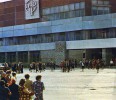
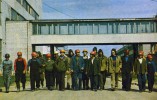
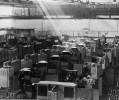
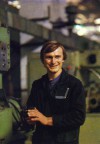




























































The renovation
 The renovation of the non-chernozem lands, the complex programme which has been worked out by the Communist Party and is now successfully being brought into life, determines the entire economic and cultural development of the Pskov Region — this vast agricultural area in northwestern Russia.
Collective and state farmers effectively and sparingly use huge capital investments and up-to-date machinery. They are provided with grains of the most highyielding varieties, accurate cartograms for using fertilizers and а ramified chemical service; close contacts are maintained with famous scientists in the country... And the generous earth gives much in reward for the hard work.
The once marsh-ridden areas that had long been considered to be of по value were transformed into boundless fields used for the cultivation of cereals, flax and potatoes. Melioration has become one of the main means of raising the standard of agriculture. During the tenth five-year plan alone, about 100,000 hectares have been added to the available sowing area; every year they yield а harvest 150% higher than that gathered in the old ploughflields.
Flax fields are the pride and wealth of the Pskovian Land. It is not accidental that it is called the "flax republic of Russia".
Cattle-breeding, another highly developed branch of local agriculture is steadily being modernized on an industrial basis. Old farms are reconstructed in kolkhozes, sovkhozes and agro-industrial association, and new large complexes for the production of meat, milk and eggs are being built. Today all technological processes in cattle-breeding are mechanized.
Year after year the renovation оГ the non chernozem lands is carried out more rapidly and effectively. Not only the conditions of the peasant's toil are changing radically, but the entire pattern оГ life and outlook оГ the tiller of the soil as well. The Soviet peasant has become an active social force; his work is greatly respected by people from all walks of life. It is not by chance that sixteen of the best Pskovian farmers earned the title of Него of Socialist Labour.
The renovation of the non-chernozem lands, the complex programme which has been worked out by the Communist Party and is now successfully being brought into life, determines the entire economic and cultural development of the Pskov Region — this vast agricultural area in northwestern Russia.
Collective and state farmers effectively and sparingly use huge capital investments and up-to-date machinery. They are provided with grains of the most highyielding varieties, accurate cartograms for using fertilizers and а ramified chemical service; close contacts are maintained with famous scientists in the country... And the generous earth gives much in reward for the hard work.
The once marsh-ridden areas that had long been considered to be of по value were transformed into boundless fields used for the cultivation of cereals, flax and potatoes. Melioration has become one of the main means of raising the standard of agriculture. During the tenth five-year plan alone, about 100,000 hectares have been added to the available sowing area; every year they yield а harvest 150% higher than that gathered in the old ploughflields.
Flax fields are the pride and wealth of the Pskovian Land. It is not accidental that it is called the "flax republic of Russia".
Cattle-breeding, another highly developed branch of local agriculture is steadily being modernized on an industrial basis. Old farms are reconstructed in kolkhozes, sovkhozes and agro-industrial association, and new large complexes for the production of meat, milk and eggs are being built. Today all technological processes in cattle-breeding are mechanized.
Year after year the renovation оГ the non chernozem lands is carried out more rapidly and effectively. Not only the conditions of the peasant's toil are changing radically, but the entire pattern оГ life and outlook оГ the tiller of the soil as well. The Soviet peasant has become an active social force; his work is greatly respected by people from all walks of life. It is not by chance that sixteen of the best Pskovian farmers earned the title of Него of Socialist Labour.





















































































The main wealth
 The main wealth of the region is its people - our contemporaries who live a full-bloodied,
interesting life.
The main wealth of the region is its people - our contemporaries who live a full-bloodied,
interesting life.The Pskovian Land that once nurtured the talents of Pushkin and Rimsky-Korsakov, Mussorgsky and Sophia Kovalevskaya, today gives all its sons and daughters the opportunity to develop their gifts and perfect their skills.
The educational establishments of the i. region prepare qualified specialists for different branches of economy. Vocational and technical schools turn out over 3,000 people annually. Every morning the spacious halls and rooms of higher and technical schools throw their doors open to thousands of future teachers, engineers, agriculturists and live-stock experts, economists, sports coaches, ballet masters and musicians.
The Pskovian Land is becoming more and more beautiful. Even in its out-of-the-way parts one can see well-appointed polyclinics and schools, department stores and personal service shops.
In the evenings when the lights of the theatres and houses of culture go up many people hurry there. There are three professional theatres in the region while the number of people's theatres is ten times higher!
Power and adroitness, endurance and courage, and, most important, an enviable health - these are the, main benefits that athletes eventually gain. They have at their disposal stadiums and sporting grounds, a hippodrome, swimming pools and rowing-clubs. It is quite natural that in this land of rivers and lakes rowing is especially popular. Sportsmen of' the region take part in competitions at national and world level, such as the recent Olympic Games in Moscow. People of different ages, occupations and interests, united by a common passion for traveling, make many fascinating discoveries. Their routes pass through ancient Russian towns and preservation zones in the region, through places associated with glorious military events. On a holiday every Pskovian can undertake what he or she likes best: either to go skiing in a snow-covered forest or to enjoy a book in the quiet of a reading-room: either to fish on the lonely shore of a crystal-clear lake or to watch a soccer match in a crowded stadium: some prefer to admire a painting by a favorite artist or to attend a concert of symphony music...














































































The Pushkin Preservation Zone
 The Pushkin Preservation Zone... Here everything is reminiscent of the great poet,
striking a responsive chord in the heart of a visitor.
The Pushkin Preservation Zone... Here everything is reminiscent of the great poet,
striking a responsive chord in the heart of a visitor.This preservation zone, set up in 1922 by decree of the Soviet government, includes the village of Mikhailovskoye, the country estate of Pushkin's mother; Trigorskoye, the property of his friends, the Osipovs-Wulfs; the ancient gorodishche Voronich and Savkina Hill; Cannibal's patrimony Petrovskoye, and the white-stone Sviatogorsky Monastery. Through all his life, the poet carried his passionate love for these hills, groves and meadows, finding in their captivating beauty a permanent source of inspiration. During the two years spent in Mikhai-lovskoye Pushkin wrote over 100 different works, among them the tragedy Boris Godunov, the main chapters of Eugene Onegin, the poem Count Nulin, the lyrical masterpieces I Remember a Wonderful Moment, The Winter Morning, The Bacchanal Song, and other verses; here he started work on his first story Peter the Great's Nigger.
All the year round thousands of people come here to pay tribute to Pushkin. However, only a few of the visitors can remember what a sorry sight this place, sacred to Russian culture, was after the expulsion of the Fascist barbarians. The ravages of war have long been repaired but work in the preservation zone is carried on even today. Using old drafts and plans, archival documents and memories left by contemporaries, Soviet experts restore with great care various household structures, windmills, pergolas, orchards, park avenues - the very charm of nature that once so fascinated Pushkin is being recreated. Years pass by, but on the first Sunday of June streams of people come as before to Pushkinskiye Gory (Pushkin Hills). There begins the All-Union Festival of Poetry. On this day everywhere - by the walls of the Sviatogorsky Monastery, near the poet's modest grave, and on the wide glade in Mikhailovskoye-the air is filled with the sounds of different languages. Writers and poets from all parts of the Soviet Union and the world make speeches and read verse, expressing their admiration for the eternal, unfading beauty of Pushkin's poetry.



































000010906
1999-2025 (C) Vladislav Staroselskiy
